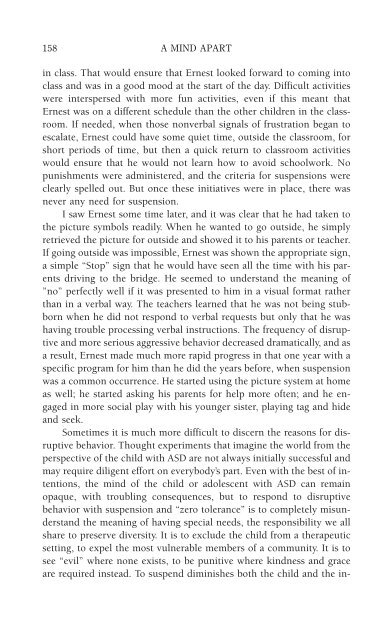978-1572305441
autism
autism
Create successful ePaper yourself
Turn your PDF publications into a flip-book with our unique Google optimized e-Paper software.
158 A MIND APART<br />
in class. That would ensure that Ernest looked forward to coming into<br />
class and was in a good mood at the start of the day. Difficult activities<br />
were interspersed with more fun activities, even if this meant that<br />
Ernest was on a different schedule than the other children in the classroom.<br />
If needed, when those nonverbal signals of frustration began to<br />
escalate, Ernest could have some quiet time, outside the classroom, for<br />
short periods of time, but then a quick return to classroom activities<br />
would ensure that he would not learn how to avoid schoolwork. No<br />
punishments were administered, and the criteria for suspensions were<br />
clearly spelled out. But once these initiatives were in place, there was<br />
never any need for suspension.<br />
I saw Ernest some time later, and it was clear that he had taken to<br />
the picture symbols readily. When he wanted to go outside, he simply<br />
retrieved the picture for outside and showed it to his parents or teacher.<br />
If going outside was impossible, Ernest was shown the appropriate sign,<br />
a simple “Stop” sign that he would have seen all the time with his parents<br />
driving to the bridge. He seemed to understand the meaning of<br />
”no” perfectly well if it was presented to him in a visual format rather<br />
than in a verbal way. The teachers learned that he was not being stubborn<br />
when he did not respond to verbal requests but only that he was<br />
having trouble processing verbal instructions. The frequency of disruptive<br />
and more serious aggressive behavior decreased dramatically, and as<br />
a result, Ernest made much more rapid progress in that one year with a<br />
specific program for him than he did the years before, when suspension<br />
was a common occurrence. He started using the picture system at home<br />
as well; he started asking his parents for help more often; and he engaged<br />
in more social play with his younger sister, playing tag and hide<br />
and seek.<br />
Sometimes it is much more difficult to discern the reasons for disruptive<br />
behavior. Thought experiments that imagine the world from the<br />
perspective of the child with ASD are not always initially successful and<br />
may require diligent effort on everybody’s part. Even with the best of intentions,<br />
the mind of the child or adolescent with ASD can remain<br />
opaque, with troubling consequences, but to respond to disruptive<br />
behavior with suspension and “zero tolerance” is to completely misunderstand<br />
the meaning of having special needs, the responsibility we all<br />
share to preserve diversity. It is to exclude the child from a therapeutic<br />
setting, to expel the most vulnerable members of a community. It is to<br />
see “evil” where none exists, to be punitive where kindness and grace<br />
are required instead. To suspend diminishes both the child and the in-



